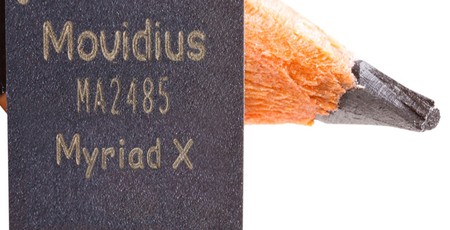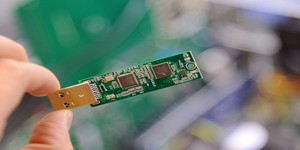Intel has announced the first new product to appear from its Movidius subsidiary since it acquired the company back in 2016: the Movidius Myriad X vision processing unit (VPU) accelerator for 'AI at the edge'.
With the desktop, laptop, server, and high-performance compute markets all but sewn up, Intel has been casting its net increasingly wide in search of continued growth. An area showing considerable promise for that growth is in machine intelligence and deep learning, and in 2016 the company announced the acquisition of machine vision acceleration specialist Movidius in an attempt to break into the low-power local accelerator market. For nearly a year the freshly-acquired Movidius went silent, until last month Intel announced the Movidius Neural Compute Stick USB-connected accelerator - a rebranded and repackaged version of the Movidius Fathom announced more than a year prior.
Now Intel has announced the first new Movidius product since it acquired the company: the Myriad X vision processing unit (VPU), the successor to the Myriad 2 VPU which powers the Neural Compute Stick. Where the Myriad 2 offers a claimed 100-150 gigaflops - 100-150 billion floating-point operations per second - of compute performance, the Myriad X is said to be 10 times faster at over a teraflop of peak compute performance.
Other improvements over the Myriad 2 include the presence of 16 programmable 128-bit very long instruction word (VLIW) vector processors optimised for computer vision workloads, 16 Mobile Industry Processor Interface (MIPI) lanes for connection to up to eight high-definition cameras pushing 700 million pixels per second total, 20 new and improved hardware accelerators for boosting computer vision workloads such as depth perception from three 720p stereo pairs at 60 frames per second, and 2.5MB of on-chip memory.
A look at that list of specifications should reveal where Intel is looking to push the new Movidius chip: The autonomous and semi-autonomous vehicle industry is constantly on the lookout for computer vision hardware with a minimal power draw, and has previously been turning to rival Nvidia for its needs. With that said, although optimised for computer vision the Movidius chip can also be adapted for use in accelerating training of deep neural networks (DNNs) based on a range of frameworks including the popular Caffe and TensorFlow.
'Myriad X combines dedicated imaging, computer vision processing and – thanks to the industry-first Neural Compute Engine – high-performance deep learning inference within the same chip, and the results are opening up new realms of possibility,' claims Intel's Remi El-Ouazzane in the company's announcement. 'With this faster, more pervasive intelligence embedded directly into devices, the potential to make our world safer, more productive and more personal is limitless. From autonomous delivery drones and security cameras with contextual understanding to personal robots that have both situational and emotional awareness, Myriad X will unleash innovation for a new future of intelligent and autonomous devices.'
Thus far Intel has not announced partnerships to put the Movidius Myriad X into consumer hardware, nor has it confirmed a timescale for making the inevitable Neural Compute Stick upgrade based on the new chip available to customers.

MSI MPG Velox 100R Chassis Review
October 14 2021 | 15:04









Want to comment? Please log in.